#patterns art curate create
Text
Tumblr’s Core Product Strategy
Here at Tumblr, we’ve been working hard on reorganizing how we work in a bid to gain more users. A larger user base means a more sustainable company, and means we get to stick around and do this thing with you all a bit longer. What follows is the strategy we're using to accomplish the goal of user growth. The @labs group has published a bit already, but this is bigger. We’re publishing it publicly for the first time, in an effort to work more transparently with all of you in the Tumblr community. This strategy provides guidance amid limited resources, allowing our teams to focus on specific key areas to ensure Tumblr’s future.
The Diagnosis
In order for Tumblr to grow, we need to fix the core experience that makes Tumblr a useful place for users. The underlying problem is that Tumblr is not easy to use. Historically, we have expected users to curate their feeds and lean into curating their experience. But this expectation introduces friction to the user experience and only serves a small portion of our audience.
Tumblr’s competitive advantage lies in its unique content and vibrant communities. As the forerunner of internet culture, Tumblr encompasses a wide range of interests, such as entertainment, art, gaming, fandom, fashion, and music. People come to Tumblr to immerse themselves in this culture, making it essential for us to ensure a seamless connection between people and content.
To guarantee Tumblr’s continued success, we’ve got to prioritize fostering that seamless connection between people and content. This involves attracting and retaining new users and creators, nurturing their growth, and encouraging frequent engagement with the platform.
Our Guiding Principles
To enhance Tumblr’s usability, we must address these core guiding principles.
Expand the ways new users can discover and sign up for Tumblr.
Provide high-quality content with every app launch.
Facilitate easier user participation in conversations.
Retain and grow our creator base.
Create patterns that encourage users to keep returning to Tumblr.
Improve the platform’s performance, stability, and quality.
Below is a deep dive into each of these principles.
Principle 1: Expand the ways new users can discover and sign up for Tumblr.
Tumblr has a “top of the funnel” issue in converting non-users into engaged logged-in users. We also have not invested in industry standard SEO practices to ensure a robust top of the funnel. The referral traffic that we do get from external sources is dispersed across different pages with inconsistent user experiences, which results in a missed opportunity to convert these users into regular Tumblr users. For example, users from search engines often land on pages within the blog network and blog view—where there isn’t much of a reason to sign up.
We need to experiment with logged-out tumblr.com to ensure we are capturing the highest potential conversion rate for visitors into sign-ups and log-ins. We might want to explore showing the potential future user the full breadth of content that Tumblr has to offer on our logged-out pages. We want people to be able to easily understand the potential behind Tumblr without having to navigate multiple tabs and pages to figure it out. Our current logged-out explore page does very little to help users understand “what is Tumblr.” which is a missed opportunity to get people excited about joining the site.
Actions & Next Steps
Improving Tumblr’s search engine optimization (SEO) practices to be in line with industry standards.
Experiment with logged out tumblr.com to achieve the highest conversion rate for sign-ups and log-ins, explore ways for visitors to “get” Tumblr and entice them to sign up.
Principle 2: Provide high-quality content with every app launch.
We need to ensure the highest quality user experience by presenting fresh and relevant content tailored to the user’s diverse interests during each session. If the user has a bad content experience, the fault lies with the product.
The default position should always be that the user does not know how to navigate the application. Additionally, we need to ensure that when people search for content related to their interests, it is easily accessible without any confusing limitations or unexpected roadblocks in their journey.
Being a 15-year-old brand is tough because the brand carries the baggage of a person’s preconceived impressions of Tumblr. On average, a user only sees 25 posts per session, so the first 25 posts have to convey the value of Tumblr: it is a vibrant community with lots of untapped potential. We never want to leave the user believing that Tumblr is a place that is stale and not relevant.
Actions & Next Steps
Deliver great content each time the app is opened.
Make it easier for users to understand where the vibrant communities on Tumblr are.
Improve our algorithmic ranking capabilities across all feeds.
Principle 3: Facilitate easier user participation in conversations.
Part of Tumblr’s charm lies in its capacity to showcase the evolution of conversations and the clever remarks found within reblog chains and replies. Engaging in these discussions should be enjoyable and effortless.
Unfortunately, the current way that conversations work on Tumblr across replies and reblogs is confusing for new users. The limitations around engaging with individual reblogs, replies only applying to the original post, and the inability to easily follow threaded conversations make it difficult for users to join the conversation.
Actions & Next Steps
Address the confusion within replies and reblogs.
Improve the conversational posting features around replies and reblogs.
Allow engagements on individual replies and reblogs.
Make it easier for users to follow the various conversation paths within a reblog thread.
Remove clutter in the conversation by collapsing reblog threads.
Explore the feasibility of removing duplicate reblogs within a user’s Following feed.
Principle 4: Retain and grow our creator base.
Creators are essential to the Tumblr community. However, we haven’t always had a consistent and coordinated effort around retaining, nurturing, and growing our creator base.
Being a new creator on Tumblr can be intimidating, with a high likelihood of leaving or disappointment upon sharing creations without receiving engagement or feedback. We need to ensure that we have the expected creator tools and foster the rewarding feedback loops that keep creators around and enable them to thrive.
The lack of feedback stems from the outdated decision to only show content from followed blogs on the main dashboard feed (“Following”), perpetuating a cycle where popular blogs continue to gain more visibility at the expense of helping new creators. To address this, we need to prioritize supporting and nurturing the growth of new creators on the platform.
It is also imperative that creators, like everyone on Tumblr, feel safe and in control of their experience. Whether it be an ask from the community or engagement on a post, being successful on Tumblr should never feel like a punishing experience.
Actions & Next Steps
Get creators’ new content in front of people who are interested in it.
Improve the feedback loop for creators, incentivizing them to continue posting.
Build mechanisms to protect creators from being spammed by notifications when they go viral.
Expand ways to co-create content, such as by adding the capability to embed Tumblr links in posts.
Principle 5: Create patterns that encourage users to keep returning to Tumblr.
Push notifications and emails are essential tools to increase user engagement, improve user retention, and facilitate content discovery. Our strategy of reaching out to you, the user, should be well-coordinated across product, commercial, and marketing teams.
Our messaging strategy needs to be personalized and adapt to a user’s shifting interests. Our messages should keep users in the know on the latest activity in their community, as well as keeping Tumblr top of mind as the place to go for witty takes and remixes of the latest shows and real-life events.
Most importantly, our messages should be thoughtful and should never come across as spammy.
Actions & Next Steps
Conduct an audit of our messaging strategy.
Address the issue of notifications getting too noisy; throttle, collapse or mute notifications where necessary.
Identify opportunities for personalization within our email messages.
Test what the right daily push notification limit is.
Send emails when a user has push notifications switched off.
Principle 6: Performance, stability and quality.
The stability and performance of our mobile apps have declined. There is a large backlog of production issues, with more bugs created than resolved over the last 300 days. If this continues, roughly one new unresolved production issue will be created every two days. Apps and backend systems that work well and don't crash are the foundation of a great Tumblr experience. Improving performance, stability, and quality will help us achieve sustainable operations for Tumblr.
Improve performance and stability: deliver crash-free, responsive, and fast-loading apps on Android, iOS, and web.
Improve quality: deliver the highest quality Tumblr experience to our users.
Move faster: provide APIs and services to unblock core product initiatives and launch new features coming out of Labs.
Conclusion
Our mission has always been to empower the world’s creators. We are wholly committed to ensuring Tumblr evolves in a way that supports our current users while improving areas that attract new creators, artists, and users. You deserve a digital home that works for you. You deserve the best tools and features to connect with your communities on a platform that prioritizes the easy discoverability of high-quality content. This is an invigorating time for Tumblr, and we couldn’t be more excited about our current strategy.
65K notes
·
View notes
Text
youtube
Here's the new single from my album Javelin. Video animated by Stephen Halker. “Will Anybody Ever Love Me?” More info here.
THANK YOU.
Quick background about the video: my friend Stephen Halker took elements from the album art that I made (collage, paper arts, paintings etc.) and incorporated them into these really wild CGI fantasy landscapes that he created. He sent me some notes about his process and approach that I thought were really cool, if you're interested.
From Stephen:
"This is what I was really thinking about when i made this video:
It's like walking into someone's soul. First they put up these facades that look normal, but then you find out how messy they are.
I wanted it to start out super normal and cultivated. a landscape made flat by the machinations of an agrarian society.
Then a nice walk through a forest. nothing special. but more wild
Then the expanse of a grand canyon.... but you go, "hey what's that thing on the ground? Is that supposed to be there?
The grasslands are when you start to see curated memories. clean circles of thoughts. Everything is still manageable, manicured, controlled. but what's that on the horizon. looks like there's some bigger thoughts buried in those grassy north dakotan buttes.
Then comes the chorus. You gotta mix it up for the chorus. This scene is called darklands in my computer. I made the hexagons to reference Carrie and Lowell. i thought of this structure as if it was the longings of the heart. this sort of plinth of idols. Starting with the starlet from the "Will anybody ever love me" page of the booklet. Then transferring that longing to archetype.... then parents, family, friends, the love of the masses...
Once you know this much about someone, the rest of it is just is just a continuation of craziness. I wanted to morph from contained circles toward individual cut out shapes.
moving through different corridors and memories.
Obsessing over one memory.
Building towers of meaning, trying to make sense of moments events through repetition and fortification.
Second chorus was supposed to recall some of the previous scenes. the wheat, the Planet, travelling through the same hexagons, but this time they aren't filled with icons. just patterns.
you travel through the puffy paint wormhole into a less tethered version of the self.
No more landscape. just a repetition of memories. The world has fallen away.
I've always loved phyllotaxis and golden sections. they feel very.... "this goes on forever"-y.
The image of your face split in half, thrown into this fibonacci sequence reminded me of your "perpetual self" song from avalanche (which has always stuck with me)
There's a floor again. but now it's just the triangle and tape patterns. illuminated.
Flip to the image of Katrina under the owl was giving off a strong "athena" vibe. Goddess of wisdom, craft, warfare. She could make sense of my warring emotions.
End scene."
instagram
instagram
instagram
762 notes
·
View notes
Note
Hello what do you think of Ai generated artwork and videos?
I have a whole entire blog post I wrote last year btw: The Rise of the Bots; The Ascension of the Human. (Reading it again a year later I am glad I am still validated in my thoughts)
My entire being and output as an artist is rooted in process, thought, craft and connection. I am open about my process and I share/create resources constantly. I have literally experienced the thing people mean when they say 'art transforms you' just by being so close to it every step of its making. All my comics have this centrality of personhood attached to them - if it's not obvious that the artist's hand (me) is in it, there is the characteristic focus on our emotional/cultural/artistic thread across history.
Just as NFTs and what they represent were antithetical to how I interact with the world as artist and audience, so is the use of so-called AI art. NFTs and AI Art share a common hype cycle / speculative mania that comes out from an annoying vulture mindset that only knows how to eat itself to fill its belly, so I don't expect it to last too long. However I don't appreciate the damage both things have done to the utility of the internet, the degradation of art as a commercial pathway and the destruction of the image as a historical/educational/legal tool. (Which is why I am becoming more underground and turning towards alternatives like the Web Revival, small presses, curated resources and in-person communities)
The technological concept around LLM (pattern recognition and matching it to a goal), especially for medicine and statistics, is not itself problematic, especially when it follows ethical and data handling regulations that have been defined. However, when people talk generative art, what we are talking about, and fighting against, is the exploitation of resources and labour, and the further disconnection of worker = labour, human = society artificially imposed by the Corporate MBA / techno class in the pursuit of infinite stockmarket growth which then introduces a type of brainrot that can only think of things as producing value in relation to how fast one can seize for themselves Westernised Ideals of Fame and Fortune.
Also like, this whole AI thing is part of the degradation of entertainment (the loss of small-to-medium outlets, constant mergers, nobody owning their digital streaming products they bought, the laundering of journalism/curation into press releases), the internet (the algorithimification of everything, constant spam, search engines getting worse, the worsening of socmedia as a tool) and the intellectual rigour of all information.

It's all part of this rot that's spreading outwards.
TL;DR bro I make all my art by hand and I am a nerd about informational integrity
#everytime anons ask a question of this style I am always wondering it's genuine or...#only cos if you know my work and what I am involved in you'd clearly see that I embody my position
134 notes
·
View notes
Text
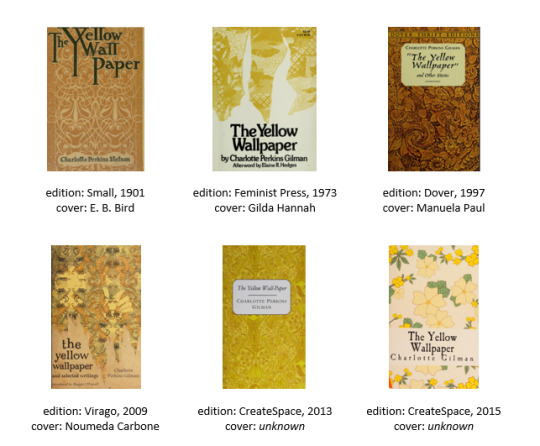
rating some covers i found on archive.org (links under readmore)
The Yellow Wall Paper
(Small, Maynard and Company, 1901; cover art by E. B. Bird)
rating: 5/5
the stark typography of the title presses almost uncomfortably to the top edge of the cover, immediately catching the viewer's attention and planting the seeds of unease. the pattern is subtle, yet intricate and the artist has clearly lifted details directly from the book's description of the titular wallpaper. the deliberate central symmetry of the composition, which is only broken up by the title, creates an impression of uncomfortable proximity and restrictedness: one would have to stand quite close indeed, to have such a perfectly symmetrical view. how long have you been standing there, following the patterns on the wall?
2. The Yellow Wallpaper by Charlotte Perkins Gilman
(Feminist Press, 1973; cover art by Gilda Hannah)
rating: 2/5
they picked a nice, sickening shade of yellow (personal opinion if mine) and it sure is torn. unfortunately the pattern is rather meh.
3. The Yellow Wallpaper and Other Stories
(Dover, 1997; cover art by Manuela Paul)
rating: 5/5
in a stroke of genius, the designer added a distortion effect to the lower part of the cover, making the already dizzying pattern look even more disorienting. a great and subtle cover, so i wont deduct points for the yellow being almost too warm.
4. The Yellow Wallpaper and Selected Writings
(Virago, 2009; cover art by Noumeda Carbone).
rating: 4.5/5.
the floral patterns are organic and intricate, but there's nothing especially unsettling about them. there's even a woman (even though she's not creeping). the overall impression is nice and it suits the book -- i quite like it
5. The Yellow Wall-Paper
(Createspace Independent Publishing Platform, 2013; artist unknown)
rating: 2/5
a nice yellow shade, though not especially sickening. the artist made an acceptable effort with the pattern (they even included a woman), but it feels kinda sparse
6. The Yellow Wallpaper
(Createspace Independent Publishing Platform, 2015; artist unknown)
rating: 0/5
it's bad. like what in the aesthetically curated instagram infographic is this. if someone locked me in a room with this wallpaper i'd become a greige minimalist momfluencer within weeks.
#🍲.txt#its just my onion etc etc#movedto book club#feel free to repost the picture if you need it for whatever or want to rate them yourself
108 notes
·
View notes
Note
dark academia stationary tips? ideas? please? i beg of you.
Deepen Your Dive into Dark Academia Stationery:

Crafting the Canvas:
Paper: Embrace the tactile – rough-edged parchment, marbled sheets, hand-dyed linen paper. Seek antique ledgers, vintage score sheets, or maps for a truly timeworn effect.
Ink: Let your words drip in history – deep emerald greens, rich burgundy, charcoal grey. Discover shimmering gold or silver for elegant annotations. For an extra flourish, explore calligraphy inks and vintage fountain pens.
Beyond the Basics:
Washi Tapes: Forget the neon, embrace botanical prints, celestial patterns, and antique library stamps. Layer them for depth, use them to seal letters, or decorate journal edges.
Stickers & Tags: Pressed leaves, dried flowers, and ephemera from library archives add a touch of natural mystery. Vintage anatomy diagrams, constellations, and old library catalog cards offer an academic flair.
Sealing Secrets: Wax seals & ribbons elevate simple letters into heirlooms. Choose deep green wax, embossed with a raven, a quill, or your own monogram. Tie with silk or hemp twine for a finishing touch.
Unleashing the Scholarly Spirit:
Journals & Notebooks: Opt for leather-bound volumes, with aged paper and ribbon bookmarks. Decorate with antique maps, pressed flowers, or handwritten quotes from your favorite poets.
Organizing Knowledge: Index cards, vintage library pockets, and antique file folders help categorize your studies. Label them with elegant script and adorn them with botanical sketches or scientific diagrams.
The Scholar's Tools: Antique brass compasses, vintage rulers, and magnifying glasses add a touch of academic ambiance to your desk.
Whispers of Antiquity:
Poetry & Letters: Handwrite in a flowing script, penning sonnets or letters to fellow scholars. Let foreign languages add a touch of mystery, or slip in quotes from forgotten classics.
Ephemera & Found Objects: Tuck pressed leaves, antique botanical prints, or ticket stubs from forgotten museums into your notebooks. Let them spark inspiration and evoke past journeys.
The Art of Storytelling: Create your own dark academia-inspired stationery. Make vintage-themed envelopes from maps, decorate boxes with constellation patterns, or craft your own wax seal stamp.
Remember, dark academia is about embracing an atmosphere. Let your creativity flow, curate your collection with intention, and transform your stationery into a portal to an enchanting world of forgotten knowledge and secret societies.
#dark academia#stationary#studying#studyblr#dark acamedia#spilled words#spilled thoughts#text#words#answered#ask#anon#replies#inbox
64 notes
·
View notes
Note
im sure you get this question all the time but how do you go about procuring those amazing outfits? do you thrift, get things tailored, make items yourself? do you buy things as you go or do you search for specific items one at the time? it's just that id love to have a style like yours (but masc haha) and i always wonder how you do it because i wouldn't know where to get clothes such as you wear anywhere, let alone for a price i can afford. and also, now im here, thank you for your amazing art, it always brightens my day when you post <3
Hello! 🥰 I collect pieces from different places that I feel fit the aesthetic I created for myself, kind of like character design, and I stick to certain silhouettes and color palettes that I already know I will feel comfortable in.
In my case I go for structured pieces instead of flowy draping ones, plain colors over patterns unless it's straight lines, earth and jewel tones on the warmer and muted side, medium height heels, gold over silver, etc. All of this makes for safe purchases for me no matter the store or outfit
Most of my clothes I buy from the historical reproduction shops I list under my posts ( I made a list some time ago here and also in the tags of each post as well as in my Instagram )
Some of these shops are on the more expensive side but offer custom tailoring which is ideal and a must for me because I'm built weird 😅 so I try to get my staple pieces there and plan the whole outfit around it before purchasing.
Then you can get the basic pieces to complete the looks from regular stores! stuff like plain shirts and trousers I usually get from places like Zara
I also thrift at curated stores which makes it easier to find interesting pieces (Edwardian revival from the 70's, capes, belts, handkerchiefs, scarves, bags and hats are some of the things I go for) I don't go with an outfit plan in mind for this, I just look around every once in a while and see what I can find and what I can do with it since it's usually very cheap too. I've also found that thrifting for masc clothes is way easier (at least where I live?) for some reason. I go antique shopping for accessories too, hats and pins from the 20's!!
Then the more specific and inexpensive stuff to tie the outfits together I get from aliexpress, (like the clock bags) and for blouses I also shop at lolita stores online sometimes
When it comes to planning outfits I just play dress up in front of the mirror like you see in the videos I make, I pull out a bunch of stuff from my closet and start matching. it helps me see what I'm missing or what colors would work best or which cut or fit creates an interesting look. It also helps you see and remember everything you have so when you are shopping or dressing up to go out you have this mental library and know whether something new will fit in with your wardrobe or not.
I also got a sewing machine some time ago and I'm teaching myself to sew! So far I've only fixed mine and my husband's clothes to make them fit but I'd love to move on to making my own clothes eventually!
I think that cultivating a personal style makes shopping for clothes easier and allows you to invest in pieces you know you will keep without fear of them going out of style and you don't feel the pressure to update your whole wardrobe every year. it's also super fun and has helped me build confidence and feel a lot more at peace with my appearance. I hope any of this helps you 😭 I rambled a lot I'll stop now!! Thank you so much for the kind words!! ❤️❤️❤️
144 notes
·
View notes
Text
Do You Have ‘Bookshelf Wealth’?
A TikTok home-décor trend has irked some bibliophiles.
By Madison Malone Kircher
Published in the New York Times, Jan. 15, 2024
When it comes to aesthetic trends, social media loves a catchy name.
Cottagecore. Dark academia. Eclectic grandpa.
Now there’s a new entry to the canon: bookshelf wealth.
On TikTok and other digital platforms, there has lately been much ado about people who own a great number of books and — this is critical — have managed to stage them in a pleasing manner.
If you’ve ever seen a Nancy Meyers movie, the look might ring a bell. Warm and welcoming. Polished, but not stuffy. A bronze lamp here. A vintage vase there (with fresh-cut flowers, of course). Perhaps there is a cozy seating area near the floor-to-ceiling display, with an overstuffed couch topped with tasteful throw pillows.
Kailee Blalock, an interior designer in San Diego, posted a video to TikTok last month that sought to define bookshelf wealth and school viewers in achieving the aesthetic in their own homes.
“These aren’t display books,” Ms. Blalock, 26, cautions in the video, which has been viewed over 1.3 million times. “These are books that have actually been curated and read.”
This literary look, she went on to say, goes well with pictures hung willy-nilly on the walls, sometimes even partly blocking the shelves, as well as mismatched fabric patterns and a bit of clutter.
In an interview, Ms. Blalock expanded on her advice. “I think to really achieve the look and the lifestyle, someone has to be an avid reader and has to appreciate the act of collecting things, especially art and sculpture,” she said.
Though Ms. Blalock did not originate the term “bookshelf wealth,” her video has spurred plenty of online discussion. “The day I ‘cultivate’ books instead of buying what I like to read is the day I’ll know I’ve truly failed as a human,” one user commented. Others remarked how bookshelf wealth was less about reading and more about regular old wealth.
Breana Newton, a legal coordinator in Princeton, N.J., who posts regularly about books on TikTok, was one of the people who responded to Ms. Blalock’s video. “I am going to show you bookshelf wealth,” Ms. Newton, 33, says in a video of her own. “Ready?”
She then gives viewers a brief tour of her home, showing books everywhere — on shelves, in overflow piles here and there, and strewed across the bed. Absent is the sense that the rooms have been staged, or that the books were bought with the consideration of how they would look on Instagram.
In an interview, Ms. Newton said that she worried trends like bookshelf wealth encourage overconsumption. This year, she added, she is trying not to buy any new books.
Another critic of the trend, Keila Tirado-Leist, said in a reaction video: “Who does it benefit to constantly have to name and qualify and attach wealth to any kind of style or home-décor aesthetic?”
Ms. Tirado-Leist, a lifestyle content creator in Madison, Wis., likened bookshelf wealth to “quiet luxury” and “stealth wealth,” styles that have recently made social media waves.
Still, she was understanding that what drives a home-décor trend like this one is a desire to create a home that feels, well, homey. In another video, she described the idea of layering — that is, slowly acquiring pieces and building up to a finished look, rather than trying to buy a bunch of things all at once in an effort to chase a trend.
“Styling a home takes time,” Ms. Tirado-Leist said.
Another TikTok user put it more bluntly in a response to Ms. Blalock’s video: “Bookshelf wealth does not mean you have books. It means you have built-ins.”
Editors’ Picks
A Practical Guide to Quitting Your SmartphoneHow Sad Love Songs Tap Into the Chaos of DatingWhen WeightWatchers Ended In-Person Meetings, They Held Their Own
Madison Malone Kircher is a Times reporter covering internet culture. More about Madison Malone Kircher
#bookshelf#bookshelf wealth#tiktok#aesthetics#home decor#books#home library#new york times#madison malone kircher
46 notes
·
View notes
Text










Last archivist I finally designed, YIPEEEE
His alternate title shall be "The Curator" C,:
Warning: long ramble below!
Trying to come up with a design for this wet-dog mf was a real pain but I managed to think of one eventually. I tried shoving in some spacey-crescent patterns along with trying to mend in a bit with subtle themes of death.
I like to thank one of my mutuals for suggesting to have his face to be more like a skull so it fits in the theme of death. Also, said skull is kinda inspired by Rher from Fear and Hunger: Termina :D

But looking at him he screams edgy; which is the point. I think his edginess would stem from his hatred from titans (one of them clawed off part of his face and he got pissy about it) Some notable characters I pictured in my head while trying to design him included Death from Puss In Boots: The Last Wish, Miguel O hara, and Sephiroth's hairstyle.
I gave him smoke-like powers because like I said in my three previous posts; I'm sticking to the archivists mirroring the four horsemen of the apocalypse idea, and ofc he's the archivist representing death. Apparently, the spirit of Hades usually follows death (you could kinda connect it the to giant ass moon) so perhaps the smoke he wields is him wielding spirit??

Creating art for this archivist was the most difficult, mainly because thinking of different compositions for the piece that had the "death vibe" while maintaining that astrological aesthetic to it ;-;.
#the archivists#toh oc#collector oc#the collector#the owl house#toh#i put cresent patterns and shapes almost all over him oops
102 notes
·
View notes
Text
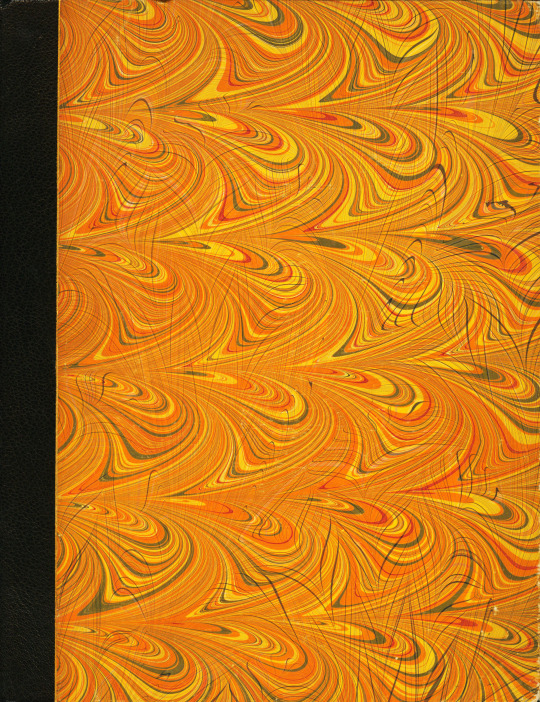
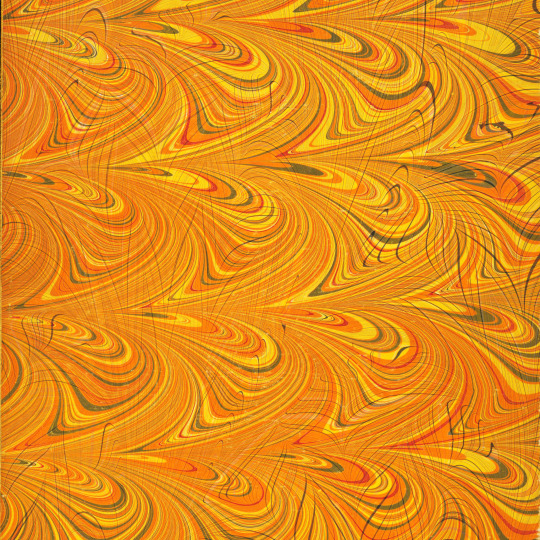
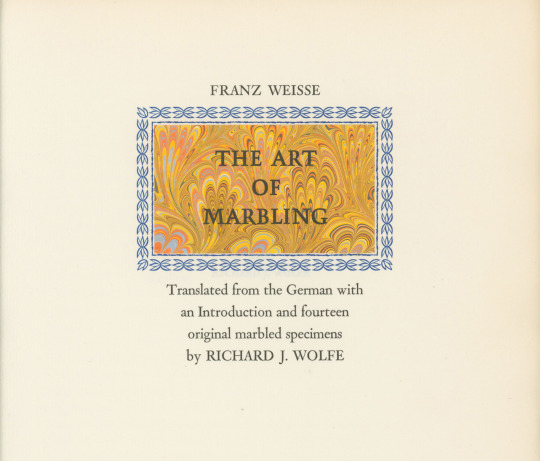

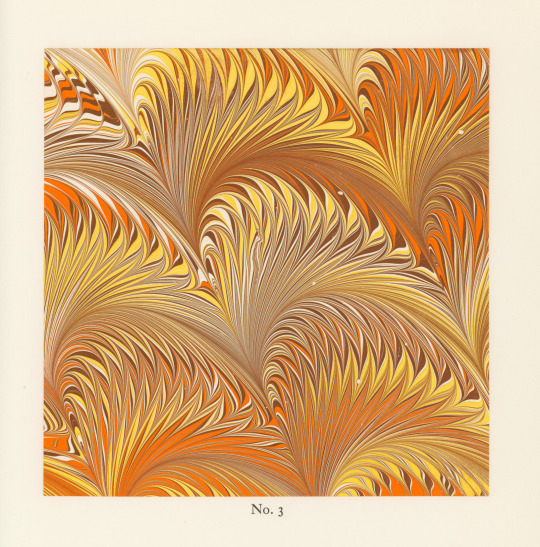

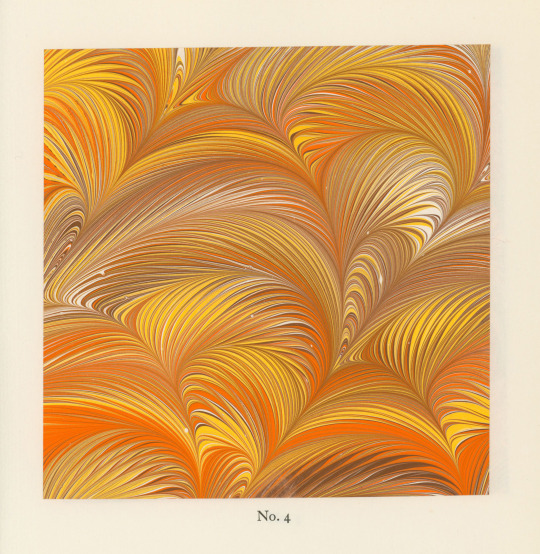
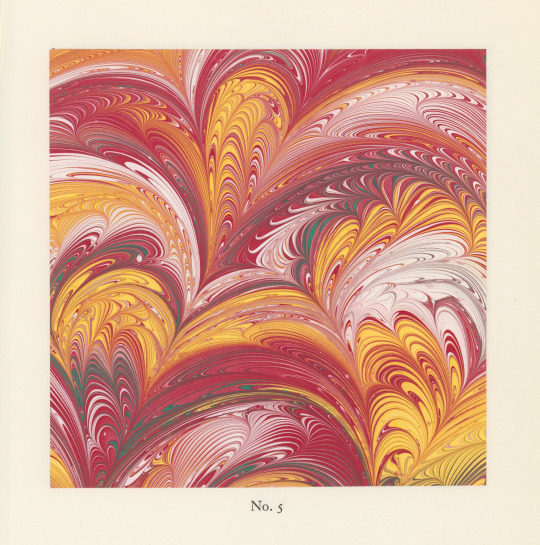
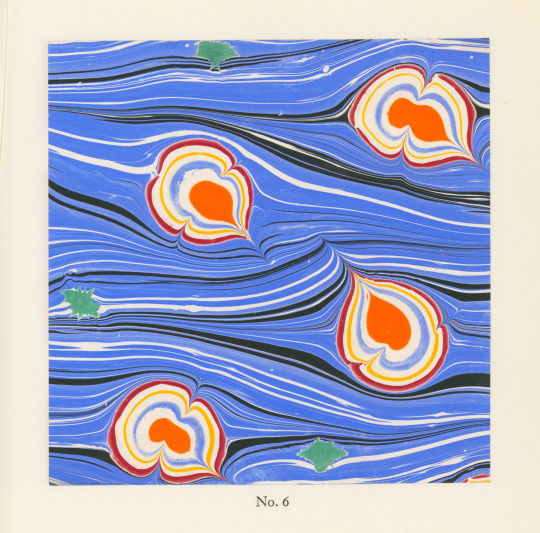
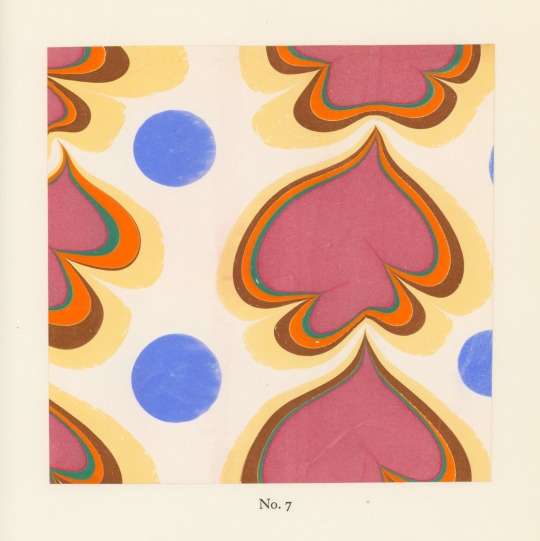

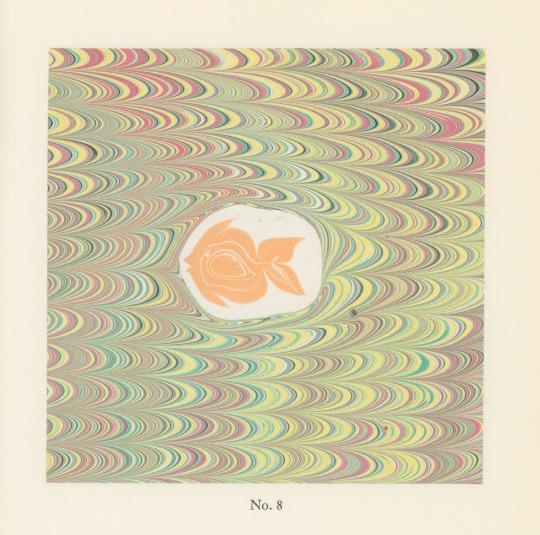
Marbled Monday
This is one of our most marble-ous books because of all the great samples of marbling it includes! This is The Art of Marbling by German marbling master Franz Weisse, translated by rare book curator, collector, and marbling expert Richard J. Wolfe. This translation of Weisse's original 1940 text was published by Bird & Bull Press in 1980. The original edition of Weisse's Die Kunst des Marmorierens... was reportedly largely destroyed by bombing during WWII and is extremely rare. The Bird & Bull publication includes a lengthy introduction by Wolfe that surveys 300 years of German marbling and Weisse's place in it.
This edition also includes 14 samples of marbled paper made by Wolfe, who also marbled the cover paper for the edition. These samples include patterns created using a needle (or stylus), fantasy marbling, and overmarbling. The cover paper is also an example of overmarbling, in which paper is marbled once and then another pattern is made on top of the first.
The Art of Marbling was published in an edition of 300 copies on Green's hand made Bird and Bull paper. It was composed using Van Dijck types by Mackenzie-Harris Corp., with binding by E.G. Parrot.
View more Marbled Monday posts.
-- Alice, Special Collections Department Manager
#Marbled Monday#marbled paper#marbling#Richard J. Wolfe#Franz Weisse#The Art of Paper Marbling#Bird & Bull Press#Bird and Bull Press#Die Kunst des Marmorierens#E.G. Parrot#Mackenzie-Harris Corp.#Alice#overmarbling#fantasy pattern#marbling art
49 notes
·
View notes
Text




Nizhónígo Hadadít’eh, They are Beautifully Dressed
Currently on exhibition at RISD Museum through September 29nth 2024
Diné (Navajo) apparel design is constantly evolving, often in response to historical events. After Spanish colonists introduced Churro sheep to what is now the Southwest United States in the late 1500s, Diné developed a Navajo-Churro breed that produced wool ideal for weaving. By the 1800s, Diné women were creating wool blankets, mantas, and other forms of apparel. After the 1868 Treaty of Bosque Redondo subjected Diné to US federal government rule, forced assimilation, and American capitalism, Diné apparel transitioned from woven wool textiles to sewn commercial fabrics. As non-Natives began collecting Diné textiles, Diné weavers also created designs for hanging on walls.
The patterns woven by Diné women in the 1800s reflect Diné aesthetics and beliefs. While we can appreciate these works through the lens of art and design, it is a disservice to overlook their cultural meanings. Diné bizaad (Navajo language; pronounced de-NEH biz-AHD) has no word for “art,” but Diné style is distinct and married to hózhó (balance, beauty, and harmony; HOZH-oh). This idea is demonstrated through symmetrical geometric design, light and dark color, and the continuance of the practice by way of matriarchal teaching.
Diné textiles were and continue to be sources of design inspiration, as well as objects of cultural appropriation. Despite hardship, Diné resilience drives creativity forward. We honor and appreciate the generations of Diné weavers who, through hózhó, have designed beautiful garments for beautiful people.
–Sháńdíín Brown (Diné), Henry Luce Curatorial Fellow for Native American Art
Shándíín Brown, Henry Luce Curatorial Fellow for Native American Art
Tʼáá íiyisíí ahéheeʼ (thank you very much) to Diné weaver Chris Brown, Diné scholar Ty Metteba, and Thierry Gentis, curator of the Haffenreffer Museum of Anthropology, for their contributions to this exhibition. Special thanks also to Diné artist Darby Raymond-Overstreet for designing the exhibition title and thumbnail.
Diné Textiles: Nizhónígo Hadadít’eh (pronounced nizh-OH-NEE-go hah-dah-DEET-eh) is the work of the Henry Luce Curatorial Fellow for Native American Art, which is funded by a generous grant from the Henry Luce Foundation. RISD Museum is supported by a grant from the Rhode Island State Council on the Arts, through an appropriation by the Rhode Island General Assembly and a grant from the National Endowment for the Arts, and with the generous partnership of the Rhode Island School of Design, its Board of Trustees, and Museum Governors.
11 notes
·
View notes
Text
Jake Xerxes Fussell—When I’m Called (Fat Possum)

Folk musician and curator Jake Xerxes Fussell was initially known for recordings with a front porch vibe. On his latest, When I’m Called, some performances hew to traditional lines. The album’s opener, “Andy,” is a story about Andy Warhol by Maestro Gaxiola, depicting a pseudo-rivalry between the artists. Fussell plays it simply, just acoustic guitar and voice, giving the song a rustic rework.
Elsewhere, new and past collaborators perform with Fussell. Like his 2022 release, Good and Green Again, James Elkington produces, creating elaborate arrangements and contributing instruments to several of the songs. Other frequent collaborators join them, including horn-player Anna Jacobsen, guitarist Blake Mills, bassist Ben Whitely, who plays both electric and upright bass and drummer Joe Westerlund. Musicians new to Fussell’s orbit include string player Jane Cook and woodwind performer Hunter Diamond. Throughout, Fussell’s understated baritone allows the words practically to speak for themselves.
Fussell culls another selection from a different source than usual. Composer Benjamin Britten collected many folk songs, arranging them for classical and scholastic musicians. Britten’s collaboration with Jane Taylor, “Cuckoo,” is given the Fussell/Elkington treatment, obscuring its rather formal source. Joan Shelley provides backing vocals on the chorus.
One of Fussell’s mentor figures, the poly artist and folklorist Art Rosenbaum, passed away in 2022. Several songs from Rosenbaum’s collection are featured on When I’m Called: “Leaving Here, Don’t Know Where I’m Going” the Scottish ballad “Feeing Day,” “Gone to Hilo,” “Who Killed Poor Robin”, and the album closer “Going to Georgia.” Each is treated a each bit differently: “Leaving Here…” has a pastoral vibe that includes winds, harmonica, and piano, “Feeing Day” has sustained horn chords in the background, “Who Killed Poor Robin” incorporates an inexorable character in the rhythm section and Elkington playing tangy organ chords and autoharp, “Gone to Hilo” has guitar soloing from Fussell and Elkington on pedal steel and organ, and “Going to Georgia” has Mills providing an extra guitar, Cook strings, Elkington organ and feedback, and Whitely and Westerlund grounding the whole in an Appalachian mid-tempo pattern. While many of the songs are given relatively brief renditions, “Going to Georgia” allows the musicians a chance to stretch out a bit.
Fussell is still a captivating figure singing by himself with a guitar; I wouldn’t want to see his front porch abandoned. However, this album's changes in approach and material invariably work. These and the talents of his collaborators help When I’m Called to be one of Fussell’s strongest recordings to date.
Christian Carey
#jake xerxes fussell#when I'm called#fat possum#christian carey#albumreview#dusted#guitar#americana#folk
5 notes
·
View notes
Text
Tidal Pendulum: Unveiling Oceanic Insights
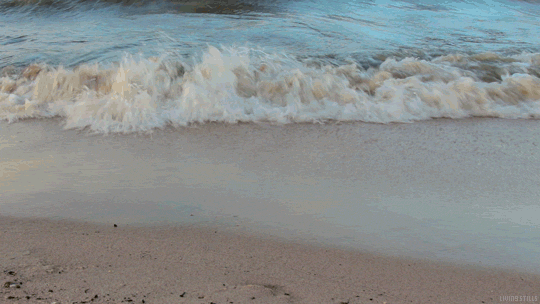
🔍 Understanding the Tidal Pendulum:
The Tidal Pendulum represents a convergence of craftsmanship and elemental energies. Rooted in the timeless tradition of divination, this instrument capitalizes on the symbolic resonance of oceanic components to facilitate a nuanced connection with the natural forces governing the tides.
🐚 Materials and Symbolic Significance:
Seashells 🌀: Each seashell integrated into the Tidal Pendulum embodies a specific elemental energy and imparts symbolic significance. Choose from a curated selection to align your divination queries with the intended energetic resonance.
Driftwood 🌲: Crafted from weathered driftwood, the pendulum's handle symbolizes resilience, adaptability, and the cyclical nature of existence. This component serves as a grounding force, anchoring the divination process in earthly energies.
💧 The Art of Tidal Divination:
Preparation and Setting: Initiate your divination session in a tranquil environment conducive to introspection. Create an ambiance of focused contemplation by employing subdued lighting and calming elements.
Calibration of Intentions: Prior to employing the Tidal Pendulum, articulate your intentions clearly. Frame your queries with precision, allowing the pendulum to channel the nuanced guidance inherent in the ebb and flow of the tides.
Pendulum Oscillation: Engage in the divination process by allowing the Tidal Pendulum to oscillate freely. Observe the subtle movements and patterns as they unfold, interpreting each swing with deliberate consideration.
Interpreting Symbolic Movements: The pendulum's movements serve as a symbolic language, akin to the rhythmic language of the tides. Develop a nuanced understanding of these movements, interpreting them as responses to your queries.
Closure and Reflection: Conclude your divination session with a moment of reflection. Express gratitude for the guidance received and contemplate the insights garnered from the Tidal Pendulum's nuanced dance.
#witchcraft#water magic#sea witch#ocean spells#river rituals#lunar tides#water witchery#aquatic enchantments#spellwork by the shore#mermaid vibes#underwater energy#moonlit reflections#potion crafting#mystical waters#sacred wells#divination by water#nautical spells#tidal energy#sea goddess#river nymph#oceanic mysticism#water alchemy#rainwater spells#storm magic#lake rituals#enchanted seas#water spirits#aquatic symbolism#crystal-infused baths#maritime witch
20 notes
·
View notes
Text
HANÁCKÝ KROJ TRADITIONAL FOLK DRESS FROM CZECHOSLOVAKIA
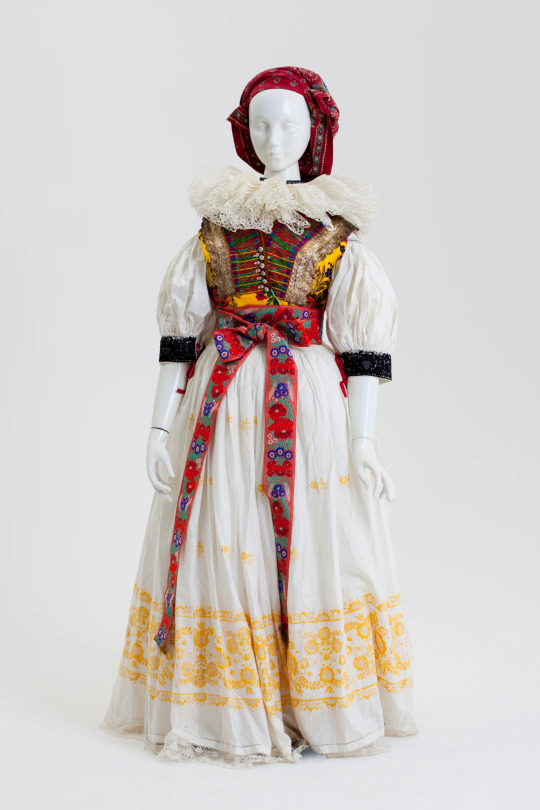


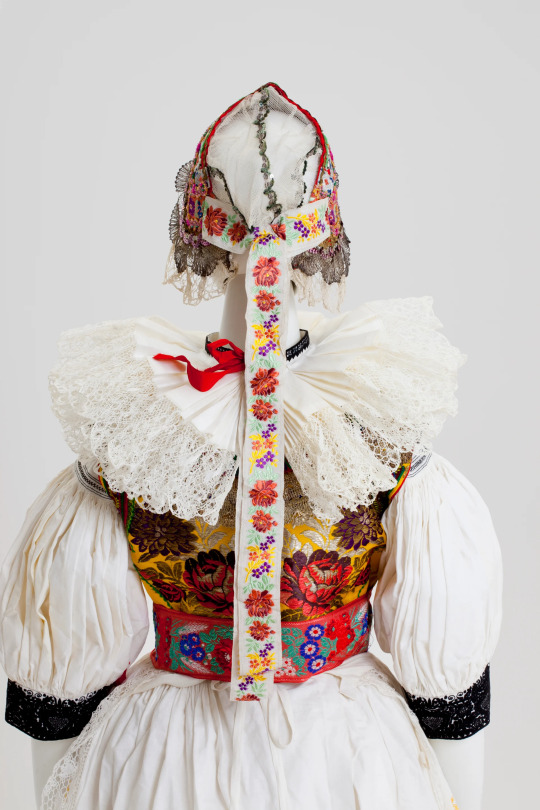


Powerhouse Collection
Outfit, hanacky kroj (traditional folk dress), womens, cotton / embroidery / lace / silk, embroidered in part and worn by Olga Kupkova (nee Skacelova), designed and made in the Hana region of Moravia, former Czechoslovakia (Protectorate of Bohemia and Moravia), 1940
This women's hanacky kroj dating from 1940 is a well provenanced example of traditional dress from the Hana region of Moravia in Czechoslavakia. Worn and partly made by Olga Kupkova the dress includes twelve components, intricately constructed and embroidered by specialist seamstresses and needleworkers, reflecting the time, expense and variety of skills that go into creating hanacky kroj. The style and design reflect the importance placed on communicating and celebrating regional identity through dress. In addition its elaborate composition and embellishment are meant to remind the viewer that it originates from Hana, one of the most prosperous areas of Moravia, which was renowned for producing the richest and most complicated designs. The related Hanacky Kroj book explains the social significance of the hanacky kroj, the very specific conventions for manufacture and wear. This is reinforced through the inclusion of patterns for components of the outfit and embroidery, step by step instructions on how to make it and information on the fabric, threads, starches and the costs involved as well as the names and addresses of specialist makers including shoe makers, embroiderers, lace makers and seamstresses who can assist with making components of the outfit. The social and cultural importance of kroj is explained in the introduction by Dr Jan Kuhndel 'Kroj is an expensive, precious and sacred symbol of national and tribal tradition. It is a child of the Baroque era and its style, in which Czech soul found its festive days, cultural base and unqiue folk art. Every kroj is a mirror and a expression of its era, its region, and its people.' Furthermore, as records of Czechoslovakian immigration in New South Wales, the garments form part of an important historical narrative concerning the experience of refugee escape and settlement in Australia. The significance of the costume collection is further increased by its well provenanced history associated with the Skacelova/Kupkova/Slezacek family and the accompanying photographs of Olga Kupkova wearing the hanacky kroj and Olga Slezacek wearing the childs traditional dress. Glynis Jones, Curator and Sarah Crowe, intern, May 2011. References Cizkova, M. and V, Prostejove. 1940. Hanacky Kroj, Czechoslovakia. Hargreaves, B. n.d. Migrants of the Nepean Valley. NSW. Snowden, J. 1979. The Folk Dress of Europe. Mills and Boon: London, Sydney, Toronto.
26 notes
·
View notes
Text
Is It Gender Play?: A Case Study in Masculine Presentation in Fashion
So first off I want to start by saying that this is about the clothing and it is not about Oliver. These items were chosen by a stylist to serve the aesthetic of ABookOf. He is indirectly involved because he happens to be the one wearing them, his presence does have an effect as this takes on the perspective that he is as far as I know, a cis man. The clothes are the material and in this case he is the canvas– which still has an effect on the artwork at the end but is not manipulated. I am going to be using a feminine, center, masculine approach to this because it’s the best way I can conceptualize this clearly, not because that's how gender and presentation works. Got it? Cool! Let's go!
ABookOf is a Arts & Culture publication that focuses on storytelling that has a bright and fun aesthetic that is not directly but in the vein of Camp. As a part of their mission statement they state that they strive to highlight “Your brand, your stories, your journey and your talent…through the artistic eyes of our team and collaborators…”
This ensemble curated by Andrew Philip Nguyen, Fashion Editor of ABookOF, is a look that plays with pattern and masculinity.
The bold orange shirt that has a slight pattern on it, that is indecipherable at the moment. This appears to be a traditional button up, styled with a red polka dot ribbon. This is what pulls it toward the center in terms of presentation as it evokes that of a traditionally feminine pussy bow blouse while also resembling a traditionally masculine tie. The other styling choice that adds to the mixture is that it is unbuttoned revealing the white undershirt.
The other attention grabbing piece in this ensemble are the boots. They are a traditionally masculine combat boot style that has been adopted by various “deviant” subcultures aesthetic closet. What pulls attention and them more center is the bright color because bright yellow is not a usual color for shoes, for either end of the spectrum. The height of them is also eye-catching and pulls them into the subversive category as they are taller than the traditional boot and are aligned with subcultures. On a side note I love that they seem to be either Doc Martens or reminiscent of them in their design as a nod to Oliver’s origins, which connects their strive to highlight their interviewee’s story and attention to detail when selecting items for their photoshoots.
The bracelet is also traditionally masculine, and while jewelry is historically present across all genders, in combination with all the other pieces in this ensemble it adds to the playing toward center and the definitions of masculine fashion that the look is making a statement on.
The pants are deceivingly simple. Upon first glance they are the least interesting piece in the ensemble but they are one of the grounding pieces of the look. If they were plain black pants, it would all still work, but be far less intriguing. They add yet another pattern and texture to the entire ensemble that creates the Camp aesthetic that ABookOf seems to have curated.
In a nutshell, each of these items fall into the “traditionally masculine” category when stripped to their bare bones, it is the unique way they are styled and presented that pulls them center. This ensemble is an exploration of masculine presentation that slightly challenges the greater societal expectations of masculine fashion. The boundaries of which have been softening, especially in magazine photo shoots, over the past two or three years. So to answer the simple question of is this Gender Play? No, it is masculine presentation on a masculine body that falls into the family of Camp and breaks societal norms and traditions.
#idek what this is except the first essay adjacent thing i have written in a year#but this is what i am very passionate about outside of the the weewoo show so *shrug*#and its been a long time since i have had coherent thoughts in this way#so that feels good#come ask me shit about it if you want but if you are mean i will delete it#aj rambles#on steroids#aj talks fashion
58 notes
·
View notes
Text
The actual call out part of this whole thing
As said in the first post, I'm not naming names. I did tag two people in a post when I first involved myself in this situation. That was because I for one wanted them to see my response but I didn't want to reblog several other posts with the same post of myself, but I also talked about something one of them had said and mentioned a private conversation that at that point I could only assume had taken place with the second person and I didn't want to talk about them without them knowing.
(Again, the rest is under the break. I've clearly had to many thoughts to share.)
I'm not in the habit of talking about people behind their back in public posts. So I tagged them with the thought that it would give them a chance to react for themselves either by commenting on the post, reposting themselves or reaching out to me in DMs. Instead the first person blocked me sight unseen and the second never talked to me at all and consequently blocked me sometime late on Tuesday judging by when I could still access their blog and when I couldn't anymore.
In reaction to being blocked by the first person, I included this in my next post:

Interestingly enough, the first person responded with this:

No idea where I called them childish, but whatever. It's honestly par for the course of them and their friends to put words in other people’s mouths, mostly with the goal to make them look bad. I'll discuss another instance in the post about communication, too.
Despite them blocking me, they clearly still got screenshots or maybe have a second account to watch the situation. (And yes, as I have screenshots, I've obviously also friends providing me with those.) Which is a ridiculous thing, honestly. Of course everyone has the right to curate their own online experience. But if you decide to block people in a debate, step out of the debate because you are actively making it impossible to communicate with you while still vague or not so vague posting about the situation on your own blog and actively trying to pull others into the debate to lead your attacks in your stead.
This person clearly made assumptions about what I meant with my comment about blocking conversations while complaining that the other side wasn't interested in those. And I don't know, but I felt it important from the very first moment to point out this wrong assumption. I didn't talk about them blocking the artist, I talked about them blocking me for nothing else but the audacity to back up the artist instead of bowing down to their opinion. (Also, reading what I wrote again, I also wonder how the confusion could have been created at all. I clearly said I couldn't reblog some posts because I was blocked by the person who creaed the blog. How do you go from there to me talking about the artist?)
Edit: It was just pointed out to me that the artist called this person childish in the tags of their re-post of the original art that they made after the call out pots went online. I had not fully read them or at least didn't remember! But alas, another point for how convoluted the vague-posting after blocking someone is, and how much it muddles up the communication!
But that happens when you don't talk with people but just about people, isn't it? You'll make wild and wrong assumption and won't even notice it.
Also, you asked this:

My paragraphs above are the answer to it. You clearly don't want to have a conversation at all, so no one is taking you seriously enough to talk to you off anon. And you've also proven two years ago you'll put anyone on a list for just leaving kudos on the wrong fic or a like the wrong art, let alone arguing with you.
Some readers might wonder why I bring up the situation of two years ago at all. For one, of course, because one of the people I'm talking about already brought it up (and—oh how surprisingly—twisting up and outright lying about what happened). But also because there is a pattern here.
Because the root of the situation two years ago is the same group of people who started it this time as well. It is actually the exact same person who first wrote the artist and then turned unkind as soon as the artist asked for clarification, posting several times on her blog to tell people not to support the artist, all the while also complaining when that didn't work. A little over two years ago, the very first list of "undesirables" that later led to the whole explosion in fandom, came from this person.
(And I feel I need to point out, there were POC authors on this list from the very first iteration on. But of course, the list was created to make fandom safer for POC fans, even though the first iteration of the list before it got expanded wasn't even about Chimney or racism at all despite other claims by the person who brought it up in the last couple of days. It all started with some fics about Maddie that they didn't like, and denying that is so hilarious when their very first fic in response to it still holds the same passive-aggressive tag about "a response to that other awful fic". Yes, I did just go and check if you had changed your tags in the meantime.)
What I have seen from their posts, they don't care that they might have driven away a POC artist from this fandom permanently, again. While others who posted call out posts on Monday have apologized (though, in some cases not very honestly), this group has either not said anything about it or are now complaining about being the original victims (… I don’t even have words without getting really rude!) Or they claim they can harass someone publicly, but apologizing only works in private:

Do you really think the artist should be comfortable with having a private conversation with you after you already twisted and widely shared other private conversations they had with your friends? And do you really think attacking someone openly doesn't also deserve an open apology? What's a private apology worth if the person you hurt had to endure all that hurt openly but now isn't allowed to hear the apology just as openly?
There have been several claims that the conversation was always civil and there was no one asking for anyone to bully the artist:

(free sprace to show a new screenshot beginning)

Snapping at the artist in response to them asking for clarification isn't being polite. Sitting on your end of a private conversation and sharing this conversation around widely—I'm even assuming openly with everyone in your Discord and also probably looking for the worst meaning in every single word because I'm sure you had already made up your mind the artist had to be a spoiled white girl—is not being polite. I mean, part of this conversation was later—in this case I have to say thankfully because it cleared up one of the misinformation spread—even posted by someone who said to have not been involved until she wanted to boost your call out post. Claiming the attention their art gets is inflating their ego is not civil.
Creating a call out post at all, and then doubling down not once but twice (just counting the reposts, not the other posts about the topic being posted that same day), is so far away from being polite. Honestly, how can anyone think this is polite:
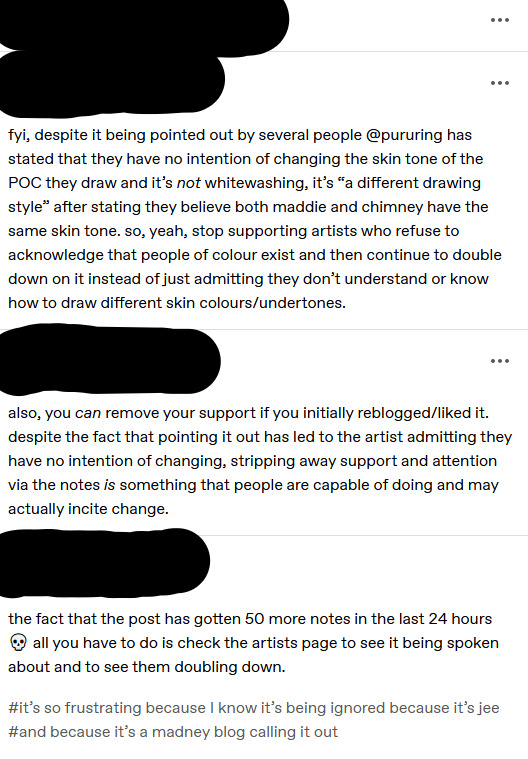
(free sprace to show a new screenshot beginning)

(free sprace to show a new screenshot beginning)

The last thing said by one of these people, I want to address this:

The way this situation went, every artist coming into this fandom in the future will very carefully think about even trying to create art about Jee-Yun. Those who already created art of Jee might decide to delete it at least from their own accounts out of fear to be hit next.
That's what your call out posts led to. And what they would have led to even if you hadn't met resistance. Wide resistance, even from people who in the past supported you. And who this time first didn't join in your call outs and later even openly spoke up against it. I truly hope those same people will step up in the future to support your victims instead of just condemning you after the damage has already been done.
I'm convinced they'll do it again, sometime in the future they'll find another victim and they'll also find once more people who'll agree with them without checking or by letting themselves be lured in by their twisted tale of it. Even now in their non-apologies (that's not including everyone who apologized, but some of them) they twist around what happened, claiming to be misunderstood or to be the victim. So they, again, clearly didn't learn anything.
I hope other parts of this fandom will have learned then to step up and support the victim even if that's sometimes a difficult step to take because it will make them a target, too, or make the situation at first worse for the victim. (I felt that way on Monday. That me getting involved would lead to the situation exploding like it did two years ago. I'm doubting this post a little because of the fear of that very thing happening, though I still feel it important to put these thoughts out there. I'm also feeling encouraged by some of the pseudo-apologies to make sure that this situation will not be forgotten. And at this point I hope if it does explode, I'll be the main target of that and not the artist.)
Why am I sure they'll find new victims in the future?
Because this is not the first time they again attacked someone over the past two years. They have targeted their old victims several times, have targeted new people, too. Both on their blogs very openly but also in their victims' comments sometimes anonymously, sometimes not. This is just the first time they found any kind of traction again. I assume because they found a victim completely new to fandom who had at the beginning no backup at all, no fandom friends to turn to for support. I do wonder now if they have found other people like this even before the events of two years ago and successfully driven them away from fandom, celebrating it in their discord server as a victory. Sadly, this also isn't the first group in fandom as a whole to behave like this. There are so many examples practically in every fandom you look at. So even if this particular group by some miracle stops being bullies, others will step into their place. So everyone else of us in fandom needs to be careful and considerate and be ready to take the risk of stepping up.
7 notes
·
View notes
Text
youtube
P E I R I A N T - New 'Dychwelyd' Album via NAWR
Welsh-Born Experiemental Drone-Folk Duo 'Peiriant' have released their sublime new album 'Dychwelyd' meaning to 'return' on the 5th of July via the Welsh experimental moniker 'NAWR Music'.
Dychwelyd explores the act of returning to source. It is born from the experience of homecoming and returning to a landscape and culture. Returning to strengthen roots and bring up a young family, albeit a move inland from where we grew up to a place dominated by hills and woven through with rivers. Y Mynyddoedd Ddu/ Black mountains of Bannau Brycheiniog frame our landscape - ancient hills with a rawness and freedom, which connect us through the ages to a sense of place.
'DYCHWELYD' TRACKLISTING
Taflu Dŵr
Y Gors
Carreg
Llethr
Cân Idris
Pits
Toriad / Agoriad
Spoons
RELEASE DATES
Friday 7th June - Single #1 - Taflu Dŵr
Friday 5th July - Album - Dychwelyd
Friday 2nd August - Single #2 - Cân Idris
BIOGRAPHY
Peiriant are a duo of violin and electric guitar, who play with melody and tonality to create atmosphere and soundscape. Electronic equipment, samples and found objects also add to their semi-improvised pieces, which are spun from grounded ideas.
Rose and Dan Linn-Pearl draw from their foundation in folk and classical in addition to post-rock, minimalism and sound art to weave experimental music that is anchored in the Welsh landscape. They play with layers of drone and dissonance, contrasting with songs and pure tones to give a rich and sonorous auditory experience.
‘Welsh-born duo Peiriant’s self-titled LP sculpts startling instrumentals from the bones of folk music, guitar delays and deep drones.’
- Jude Rogers (The Guardian)
Live performances have included BBC Radio 3: Late Junction at Chapter arts centre, Cardiff 2017, NAWR concert series (Swansea & Hay on Wye 2018 to present). They are regular performers at Nozstock festival & How The Light Gets In. In 2021 they released River Songs E.P : A collection of four pieces inspired by the River Wye.
ABOUT
Rose Linn-Pearl balances playing the violin with work as a veterinary ophthalmologist.
Early classical training and folk complemented a lifelong interest in improvisation and experimental music. Her interest now lies predominantly in tonal shifts and playing with discord and pattern.
Dan Linn-Pearl is a composer, songwriter and sound artist. His work includes alternative rock and electronic music, sound installation, experimental film and moving image under Deaf Pictures. He is a founding member of sound art collective Gwaith Sŵn who produce a monthly thematic show for award-winning arts station Resonance 104.4FM.
Both Rose and Dan are members of experimental concert series NAWR whow curate shows featuring established and up-and-coming artists. These take place in Swansea, Aberystwyth and Hay on Wye.
'Peiriant' Online
https://peiriant.bandcamp.com/https://www.instagram.com/peiriantband/
https://x.com/peiriantband?lang=en-GB
5 notes
·
View notes